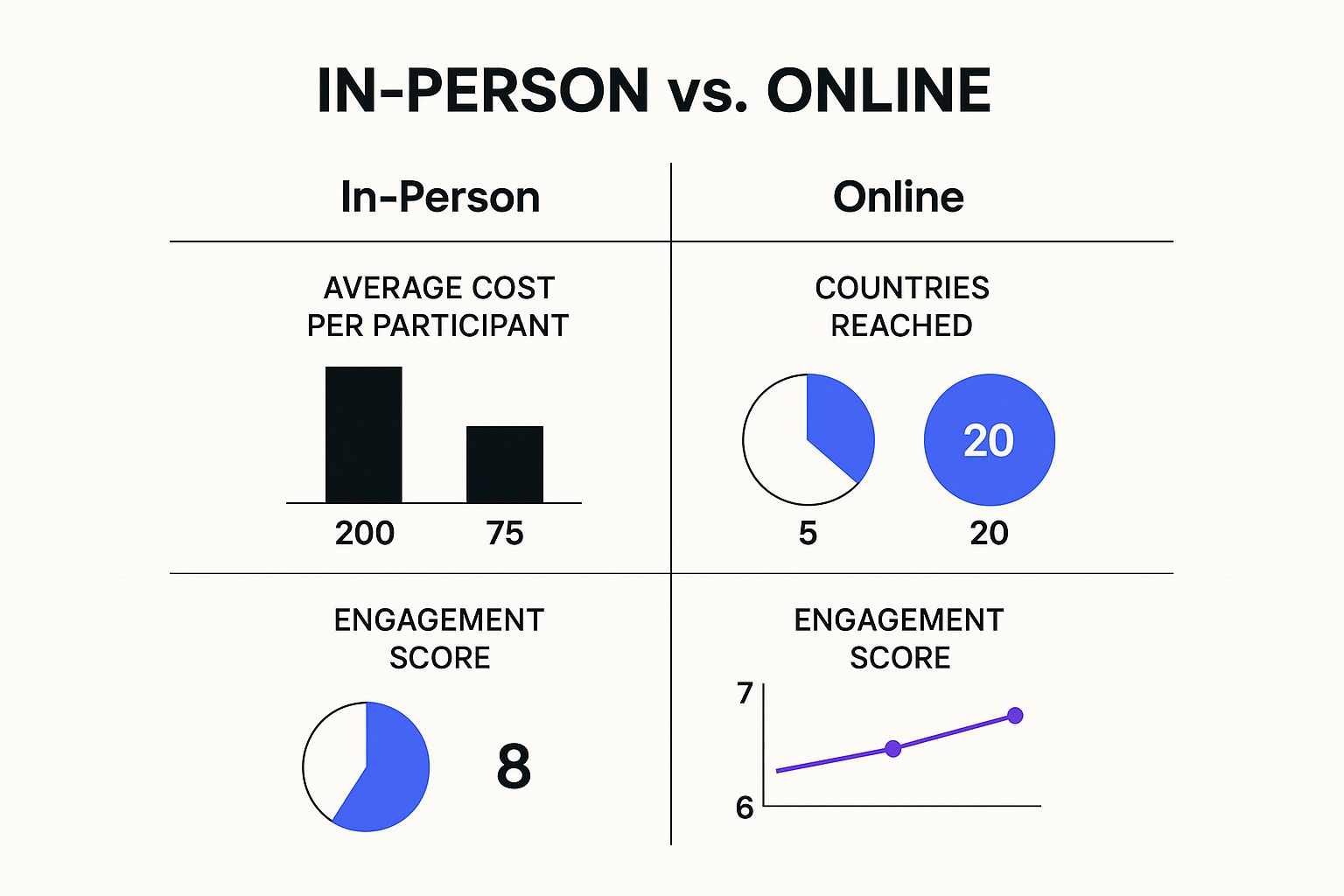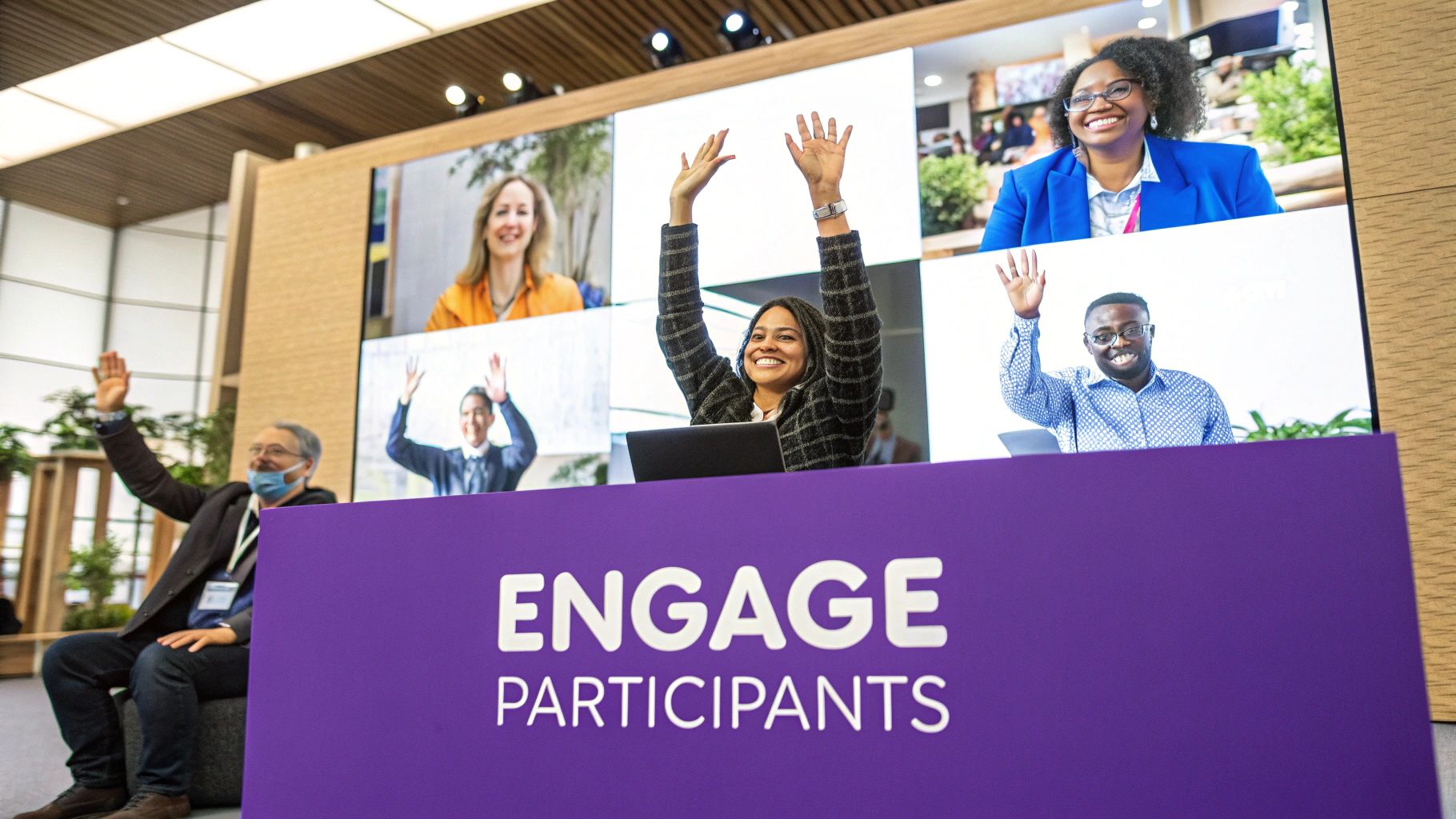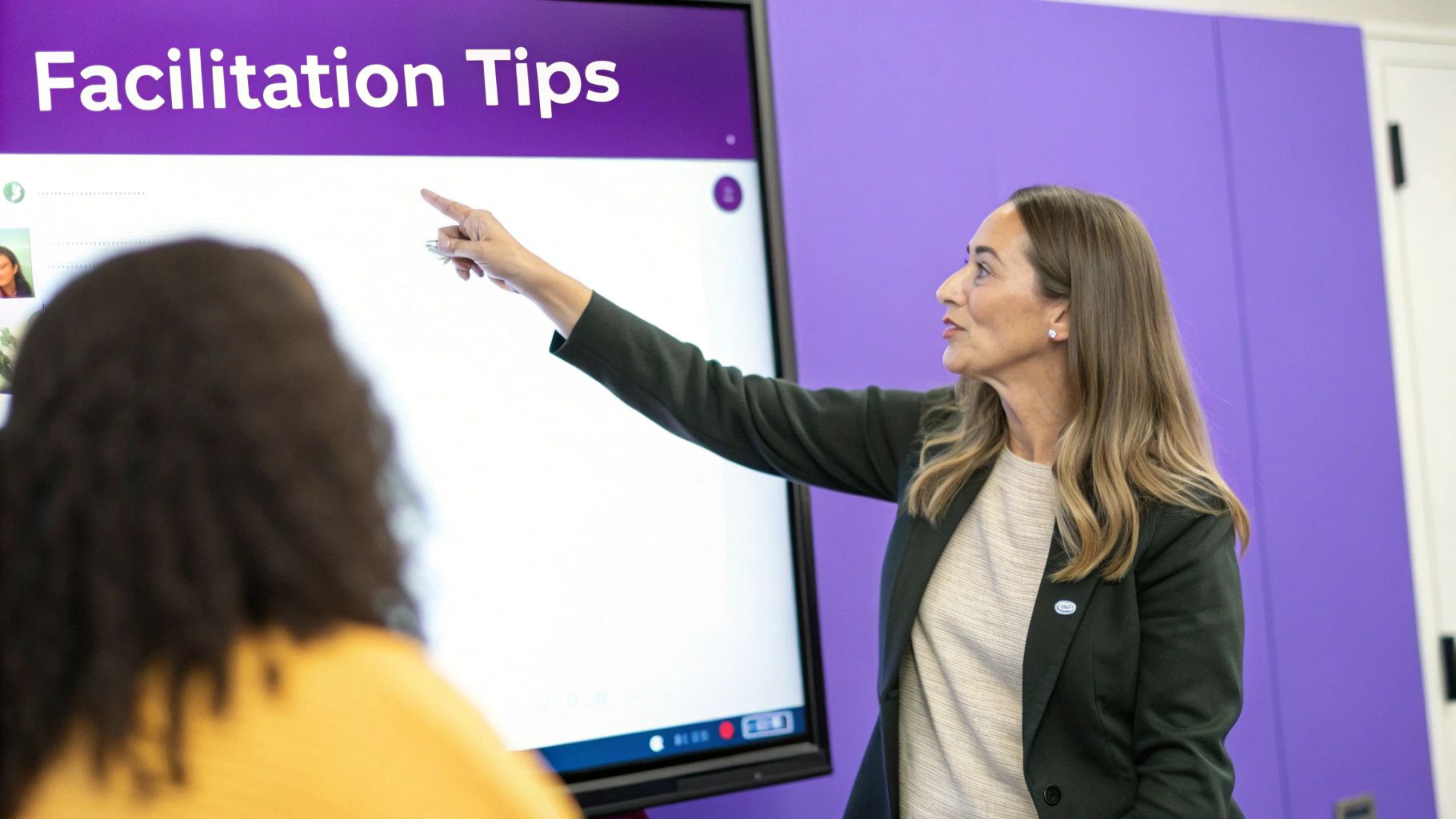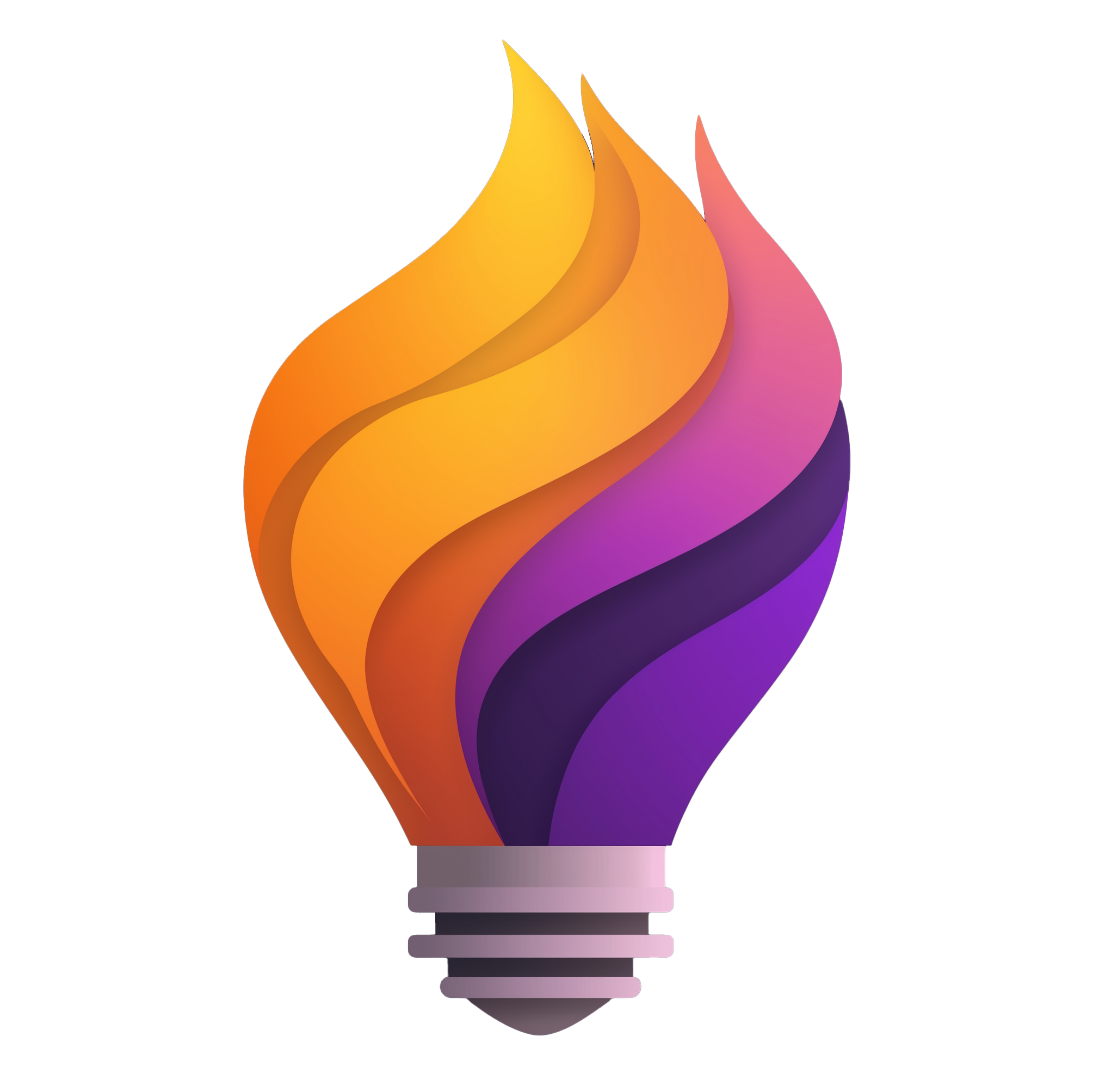Let's be honest: facilitating an online workshop isn't just about sharing your screen on a video call. It’s the craft of guiding a group of people through a virtual experience to solve a problem, make a decision, or learn something new together. The key word here is together. It’s all about creating genuine interaction, not just hosting a glorified lecture.
The Evolution of Virtual Workshop Facilitation
The days of getting away with a static, one-hour PowerPoint presentation are long gone. People expect more. They're tired of being talked at; they want to be part of a valuable, interactive experience that makes good use of their time. This big shift has really put the spotlight on what it takes to be a great online workshop facilitator.
To keep up, we've had to completely rethink our approach. You can't just take what worked in a physical conference room and drop it into a Zoom call. The digital space has its own quirks—shorter attention spans and a million distractions just a click away. The real secret is to design workshops for the virtual environment from the ground up.
Shorter Sessions, Higher Engagement
One of the biggest changes I've seen is the move away from marathon multi-hour sessions. We're now seeing incredible results with shorter, high-impact workshops. In fact, simply breaking a long workshop into focused 90-minute blocks can increase participant engagement by as much as 30%. It keeps the energy up and helps everyone stay locked in.
This isn't just about cost savings or convenience. As you can see below, a well-run online workshop can outperform its in-person counterpart on several key metrics.

The data really speaks for itself. When you facilitate properly, you not only slash the cost per person but also open the door to a global audience and see engagement metrics climb.
From Monologue to Dialogue
At its heart, this evolution is about moving from a one-way speech to a lively, collaborative conversation. Old-school webinars felt like a monologue. Modern workshops? They're all about dialogue.
A facilitator's job has shifted from being the "sage on the stage" to the "guide on the side." You're no longer expected to have all the answers. Instead, your role is to create a space where the group can find the answers together.
This means putting activities that build connection and encourage co-creation front and center. If you're looking for practical ways to do this, we've put together a guide on facilitating remote workshops that's packed with ideas.
The difference between the old and new ways of thinking is stark. This table helps illustrate the fundamental shift in how we approach online sessions.
Comparing Old vs New Workshop Facilitation
| Element | Traditional Approach (Passive) | Modern Approach (Interactive) |
|---|---|---|
| Participant Role | Audience member, passively listening | Active contributor, co-creating content |
| Communication | One-to-many (presenter to audience) | Many-to-many (group collaboration) |
| Primary Tools | Slide deck, one-way chat | Digital whiteboards, polls, breakout rooms |
| Session Goal | Information transfer | Problem-solving and skill-building |
Ultimately, great online facilitation comes down to being adaptable and human-focused. It's about designing an experience that is just as productive as it is enjoyable, blending smart process design with the right tech and a healthy dose of people skills.
Designing an Experience, Not Just a Presentation

Here’s where many online workshops fall flat: they're designed as presentations, not experiences. The facilitator builds a slide deck and talks at people. But truly effective online workshop facilitation is about architecting a journey that guides everyone toward a shared goal.
This all starts with getting laser-focused on your objectives. Forget about the slides and activities for a moment. Ask yourself this one critical question: "By the end of this session, what do I want my participants to be able to do, know, or feel differently?" Your answer is the North Star for every other decision you'll make.
For instance, an objective like "understand our new marketing strategy" is pretty weak. It’s passive. A much stronger objective is "collaboratively brainstorm three campaign ideas that align with our new marketing strategy." See the difference? The second one demands action and gives the workshop a clear, tangible purpose.
Create a Compelling Narrative Flow
With clear objectives in hand, you can start mapping out the workshop's flow. The best workshops I've run have a natural rhythm, almost like a good story. They need a solid beginning, a meaty middle, and a satisfying end. This structure isn't just for show; it helps you balance information delivery with interactive moments to keep the energy up.
Think of it like a story arc:
- The Hook: Kick things off with something that grabs everyone’s attention right away. A provocative question, a surprising statistic, or a quick personal story works wonders to connect people to the topic from the get-go.
- The Rising Action: This is where you introduce the core concepts and build up to the main event. You can mix in short bursts of content with small-group discussions in breakout rooms to keep things moving.
- The Climax: This is your main event—the big, collaborative activity where the group tackles the core objective. This is where the magic happens and the real work gets done.
- The Resolution: Time to wind down. Use this part of the workshop to solidify what everyone has learned, define clear action items, and take a moment to celebrate what the group accomplished together.
The most impactful workshops aren't just a series of disconnected activities. They are a carefully choreographed sequence where each part builds upon the last, creating momentum and leading the group toward a meaningful conclusion.
This narrative approach respects your attendees' attention and turns what could have been just another meeting into a genuinely productive and memorable event.
Balancing Content with Interaction
One of the easiest traps to fall into when facilitating online is talking for too long. I've been there. To keep your audience from zoning out, you have to intentionally weave interaction into the very fabric of your plan. A great rule of thumb I always follow is to switch things up every 15-20 minutes. This keeps people on their toes and actively involved.
Here’s what a segment of a 90-minute workshop might look like in practice:
- Welcome & Icebreaker (10 min): I might use a tool like Mentimeter for a live word cloud, asking, "What's one word you associate with today's topic?"
- Content Burst (15 min): Present the core problem. I keep this part short, sharp, and highly visual. No one wants to read a wall of text on a slide.
- Breakout Room Discussion (20 min): I'll send participants into small groups to dig into the problem, maybe using a guided prompt on a shared Miro board to capture their ideas.
- Group Share-Out (15 min): Bring everyone back and have each group share one key insight. This keeps the report-back section quick and focused.
- Action Planning (20 min): As a full group, we might use a tool like Bulby to brainstorm and then prioritize next steps based on the insights we just heard.
- Wrap-Up & Feedback (10 min): I’ll summarize the key takeaways and ask for quick feedback on the session itself.
This kind of structure ensures no single activity drags on for too long. By mixing up the formats and tools, you create a dynamic environment that puts your participants—not your slide deck—at the center of the experience.
Choosing Your Tech for a Seamless Workshop
The best tech for your workshop is the kind nobody even notices. It should just work, fading into the background so the human connection can take center stage. When I'm putting together my toolkit, I'm not looking for the flashiest new app; I'm looking for reliable, intuitive tools that help me hit my workshop goals.
Your "tech stack" is just the set of tools you'll use to run the show. You'll definitely need a solid video conferencing platform and at least one other tool for collaboration.
Core Components of Your Workshop Tech Stack
Your video conferencing platform is your virtual venue. It’s where everyone gathers. Look for one that's known for stable video and crystal-clear audio. But for me, the non-negotiable feature is top-notch breakout rooms. Without them, you can't have those crucial small-group conversations that make workshops so valuable.
Then, you need a space where people can actually do things together. This is where your collaborative tools come in.
- Digital Whiteboards: I lean heavily on tools like Miro or Mural. They’re fantastic for getting ideas out of people’s heads and onto a shared canvas with digital sticky notes, flowcharts, and more.
- Live Engagement Tools: For a quick pulse check, something like Slido or Mentimeter is perfect. You can run instant polls, manage a Q&A, or create a word cloud to see what’s on everyone’s mind.
- Structured Brainstorming Platforms: When you need to go deeper than just flinging ideas at a whiteboard, a guided tool like Bulby is a game-changer. It uses structured exercises to make sure every single person contributes and helps teams push past creative ruts.
The real question isn't "Which tools are best?" It's "How can these tools work together to create a single, fluid experience?" Your tech should support the conversation, not interrupt it.
Preparing for the Human Element of Tech
Let's be honest: even the best tools are useless if people don't know how to use them. A huge part of successful online workshop facilitation is getting your participants comfortable with the tech before the session starts. Never assume everyone’s a pro.
A few days out, I always send a simple email with clear instructions and links. This is a must. It should cover:
- The main link to join the video call.
- Links to any other tools we'll be using, with a friendly nudge to sign up for a free account ahead of time.
- A "Plan B" for how to get in touch if everything goes haywire.
The need for this digital dexterity isn't going away. Back in 2022, data showed that about 57.8% of facilitation happened online. While in-person sessions have made a comeback, the split is nearly even now. It just goes to show that as facilitators, we need to be masters of both realms. You can dig into more of this data in the full State of Facilitation 2025 report.
Finally, and I can't stress this enough, always do a tech rehearsal. A quick 15-minute run-through with a co-facilitator or your main client can save you from a world of pain. You'll catch any weird issues with screen sharing, audio, or tool permissions, making sure you look polished and prepared when it's go-time.
Mastering Virtual Presence and Participant Engagement

When you're leading an online workshop, you’re not just a presenter; you’re the director of the entire experience. Your real job is to command the virtual room, and that all comes down to your presence. It's about radiating confidence and energy through the screen, making every single person feel like they're right there with you.
It all starts with the simple things you can control. Your on-camera setup is huge. Get that webcam up to eye level—it’s the closest you’ll get to making real eye contact. Good lighting isn't vanity; it's so people can actually see your facial expressions. And for heaven's sake, make sure your audio is crystal clear. These little tech details make a massive difference in how professional and engaging you appear.
From there, it's all about how you carry yourself. Sit up, lean forward a bit to show you're tuned in, and don't be afraid to use your hands to emphasize a point. Your voice is also a powerful tool. A flat, monotone delivery is an instant audience-killer. Mix up your pitch and speed to keep the energy high and your content compelling.
Cultivating an Inclusive Environment
Let's be honest: one of the biggest hurdles in any workshop is getting everyone to talk. It's so easy for a couple of outgoing people to dominate the conversation, leaving others to fade into the background. As a facilitator, it's your mission to balance the scales and draw out those quieter voices.
A great technique I’ve used is the "warm call." It’s much less intimidating than a cold call. You can say something like, "I'd love to get a few different perspectives on this. Sarah, thinking about your marketing background, what’s your take?" This gives them a clear, respectful invitation to join in.
Your goal is to turn a one-way lecture or a two-person chat into a genuine group dialogue. This only happens when you build psychological safety, making everyone feel confident enough to share their thoughts without fear of judgment.
A fantastic way to build this safety and boost participation is by weaving in dynamic activities. If you need some inspiration, this guide to the Top 9 Interactive Workshop Activities is a great place to start.
Reading the Digital Room
Okay, this is the tricky part. How do you "read the room" when you're not actually in the room? You have to become a master of digital body language.
Keep a close eye on those little video boxes. You can learn a lot.
- Are they engaged? Look for nods, smiles, or people leaning closer to their screens. These are your green lights.
- Are they distracted? If their eyes are constantly darting away or you see the tell-tale glow of a second screen on their face, you might be losing them.
- Are they confused? A furrowed brow or a head tilt is a universal sign for "I'm not following you." Time to pause and clarify.
Breakout rooms are another area that requires careful management. Don't just throw people into a digital room and hope for the best. Always give them crystal-clear instructions and a tangible goal. For example, structuring their discussion with a Bulby template can keep them focused and ensure they come back with something valuable.
When you reconvene, have a plan for sharing. A quick "round-robin" where each group shares its single biggest takeaway works wonders. It's organized, efficient, and ensures every group gets a voice. For a more comprehensive look at these kinds of strategies, diving into established https://www.remotesparks.com/remote-facilitation-best-practices/ will give you a solid foundation to build on.
Turning a Workshop Into Lasting Impact

So, you've just run a fantastic workshop. The energy was high, ideas were flowing, and everyone signed off feeling inspired. But what happens next? The real test of a workshop's success isn't how it feels in the moment—it’s about what happens after.
Without a solid follow-up plan, all that brilliant momentum can fizzle out. Insights get forgotten, and action items fall through the cracks. The goal is to turn that single event into a springboard for real, lasting change. That’s where your post-workshop strategy comes in.
You need to send a follow-up that’s more than just a data dump. It should be a neatly packaged, valuable resource that reminds everyone of the "why" and clarifies the "what's next."
What to Share for Maximum Impact
Timing is everything. You'll want to get your follow-up email into everyone's inbox within 24 hours. Any later, and the details start to get fuzzy.
Here’s my go-to checklist for a follow-up that actually gets read and used:
- The Session Recording: Always include a link to the full recording. It’s perfect for people who want to review a specific point or for team members who couldn't make it.
- A Punchy Summary: Let’s be real—nobody has time to rewatch a two-hour session. Write a quick summary hitting the key takeaways, major decisions, and any breakthrough ideas.
- Digital Whiteboard Snapshots: Export any collaborative boards (from Miro, Mural, etc.) as a PDF or image. This gives everyone a visual artifact of the great work you did together.
- Clear Next Steps: This is the most important piece. List out the agreed-upon action items, assign an owner to each one, and include the deadlines. No ambiguity.
When the workshop is for a client, this follow-up does double duty. It's a key part of managing client expectations and shows you’re a professional who is committed to delivering results, not just running a meeting.
Gathering Feedback to Refine Your Craft
Your follow-up isn't just about giving; it's also about receiving. This is your single best chance to get honest feedback and become a better facilitator. I consider a short survey non-negotiable.
People are much more willing to share candid thoughts when the request is immediate and anonymous.
Don't overdo it with the questions. A simple, three-question survey will give you more useful information than a long, complicated one. Trust me.
Here are the three questions I always ask:
- On a scale of 1-10, how valuable was this workshop for you?
- What was the single most impactful part of the session?
- What is one thing that could have made this workshop even better?
The first question gives you a metric to track over time. The next two give you the gold—specific, qualitative feedback you can act on immediately.
This simple feedback loop is what separates the pros from the amateurs. It gives you the insight you need to tweak your methods, try out new virtual workshop ideas, and ensure every session you run is better than the last.
Answering Your Top Facilitation Questions
Even the most experienced facilitators run into tricky situations when running workshops online. It’s just a different beast. Let’s tackle some of the most common questions I hear from people trying to master the digital space.
What Do I Do About That One Person Who Won’t Stop Talking?
Ah, the classic dominator. We’ve all been there. It’s a delicate dance because you don't want to shut them down completely, but you have to make room for others.
The key is to acknowledge their point warmly and then immediately create an opening for someone else.
For example, try saying something like, "That's a fantastic point, Alex. Thank you for that. I'm curious to hear other perspectives on this. Maria, what's been your experience?" This validates their contribution while gently shifting the spotlight. Using breakout rooms is also a great strategy here, as it naturally gives quieter folks a safer space to find their voice.
How Do I Actually Keep People Engaged?
The biggest enemy of engagement is the marathon session. Nobody wants to sit through a single, three-hour virtual meeting. It’s a recipe for glazed eyes and multi-tasking.
Instead, think in shorter, focused blocks. I've found that 90-minute segments are the sweet spot, with generous breaks in between to let everyone recharge.
Within those 90 minutes, variety is your best friend. I make it a rule to switch up the activity every 15-20 minutes. You could go from a quick presentation to a poll, then jump over to a Miro board for some brainstorming, and then send everyone into breakout rooms. This constant change keeps people on their toes and actively involved.
From my experience, the magic number for a truly interactive online workshop is between 12 and 18 participants. It’s small enough for genuine connection but large enough for diverse ideas to spark.
If you’re working with a much larger group, you absolutely must lean on breakout rooms. Creating these small "pods" is the only way to replicate that feeling of intimacy and ensure everyone gets a chance to participate.
What if My Tech Fails? And Where Can I Get More Training?
First, if your tech dies mid-workshop: breathe. Your calm demeanor is everything. This is where having a backup plan isn't just nice—it's essential. Before you even start, make sure everyone has a document with an alternate contact method or a backup meeting link.
If you're looking to build up your confidence and learn how to handle these moments like a pro, formal training has become much more accessible. There are fantastic programs out there. For instance, the Collective Impact Forum runs a great course called 'Facilitating Collaborative Meetings.' It’s a six-hour session spread over two days, perfect for new facilitators or anyone needing a refresh.
Investing in structured training like this gives you the frameworks and confidence to handle anything, from a total tech meltdown to navigating a difficult group dynamic.
Ready to turn your virtual meetings from snoozefests into sessions buzzing with energy and ideas? Bulby gives you the AI-powered co-pilot and proven exercises to help your remote team do its best work. Start your journey with Bulby today.

